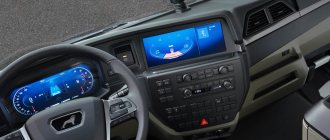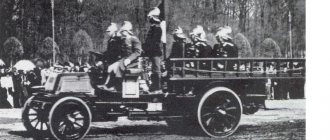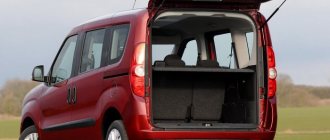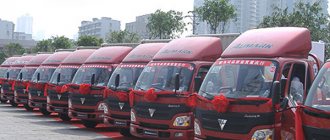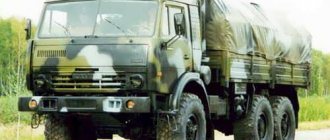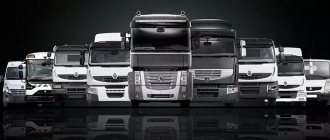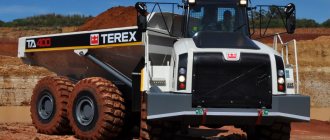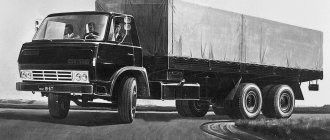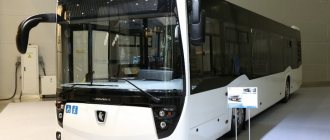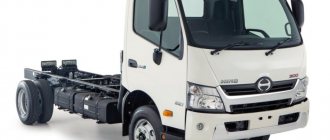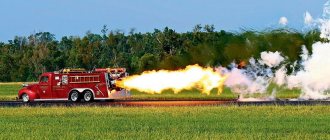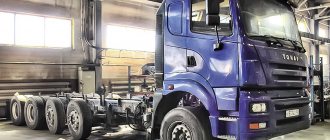MAN - Maschinenfabrik Augsburg-Nürnberg AG
is the leader in the global car market of trucks, buses and their components. Today, the international company MAN Group has several production divisions for the production of trucks, buses, diesel engines, as well as the construction of high-tech production facilities. MAN also cooperates with a number of global concerns and companies. The main office of the MAN concern is located in Munich.
All over the world, MAN trucks are in great demand and are known as reliable, high-quality, functional and comfortable, with the most pleasant combination of price and quality. A large number of awards are confirmation of global recognition, some of the latest being: “Truck of the Year” and “Coach of the Year”.
History of the MAN company (1758 - 1929)
The history of the company's creation began more than two centuries ago in 1758. The first company, Hütte St., was then founded in Oberhausen. Antony, from which the MAN consortium subsequently grew through a merger with other workshops and factories.
The real history of the concern began in 1840, when entrepreneurs Ludwig Sandler, Jean Gaspard Dollfuss and engineer Karl August Reichenbach opened the Sander'sche Maschinenfabrik machine-building plant in Augsburg. It was soon renamed C. Reichenbach'sche Maschinenfabrik in honor of the printing press designer Karl Reichenbach. It was his machines that became the main products of the enterprise, and he also headed the factory. Later the company received the name Maschinenfabrik Augsburg AG.
However, the production of trucks began already in the twentieth century. At the end of the seventies, the company began to receive the first “Truck of the Year” prizes and regularly confirmed this title.
In 1893, the first experimental diesel engine was created at the Augsburg factory.
In 1897, the world's first efficient diesel engine was created.
On November 26, 1898, on the initiative of director Anton von Rippel, the Nuremberg and Augsburg factories merged - the birth of the company Vereinigte Maschinenfabrik Augsburg und Maschinenbaugesellschaft Nürnberg AG.
In 1908 , after the name of the factory was transformed into "Machinery Factory Augsburg Nuremberg AG", as a consequence, the name MAN (MAN) appeared.
In 1915, construction of the MAN-Saurer truck plant began. Saurer assembly production is transferred from Lindau to the MAN plant in Nuremberg. Serial production of trucks starts here in Nuremberg. A production program for 2.5/3.5 ton trucks with a cardan drive has been implemented.
In 1919, the first MAN garbage collection vehicle was produced, with a motor-hydraulic dump body, created for urban transport enterprises in Germany.
In 1920, MAN merged with the Gutehoffnungshütte concern and the first MAN truck trading program was created.
In 1921, the MAN type 3Zc truck rolled off the assembly lines of the MAN plant in Nuremberg, having a 3-ton payload and equipped with a 40 and 45 hp carburetor engine. (4 cylinders). Also, the company’s specialists have developed a MAN grader for agriculture.
MAN diesel_truck 3Zc
In 1923, the first truck with a self-produced unit was produced. And since then, the production and improvement of diesel trucks began. In the same year, in Augsburg, the first automobile diesel engine with direct fuel injection, suitable for normal use, was developed, a four-cylinder, four-stroke engine with a power of 40 hp at 900 rpm. On its basis, a MAN type 3Zc truck was created, with a chain drive and 3.5 tons of payload. Some time later, the MAN company produces the first low-load diesel bus.
In 1924 , at the automobile exhibition in Berlin, the first roadworthy truck with a direct injection diesel engine with a power of 40 hp was presented.
MAN SAURER - LKW-1924 Truck with the first direct injection diesel engine.
In 1925 , MAN revolutionized the automotive industry with the introduction of a five-ton truck with a cardan drive. This was a technological breakthrough in the automotive industry, and it was the reason that the ubiquitous chain drive began to be used much less frequently, and soon disappeared completely. In addition, this truck had design features that were subsequently, for a long time, considered typical features of trucks produced by MAN. For example, the method of separating the load-bearing axle and the drive, which is called the “MAN rear axle”.
In the same year, Maschinenfabrik Augsburg-Nürnberg AG produced the MAN type ZK5 in the modification of a 4000 liter tanker (payload 5 tons, engine power 50 and 55 hp).
In 1926 , a series of two-axle trucks from 3 to 8 tons of payload, as well as a three-axle vehicle with a payload of up to 10 tons, equipped with a 150 horsepower engine, were added to the MAN truck production and sales program. The design of this “heavyweight” included a drive shaft running directly from the gearbox, a gear drive on the rear axles and external brake drums. These design features will, in the future, form the technological basis for the entire long-range MAN heavy truck program.
The year 1927 was marked by the release of the first truck with a cardan drive. In addition, at the IAA international exhibition in Cologne, along with new modifications of buses and utility vehicles, MAN presented a series of trucks on a five-ton, low-loader bus chassis. Three modifications of this model were envisaged:
- Three-axle truck, with a payload of 8 to 10 tons, a six-cylinder carburetor engine with 150 hp, a worm drive and three differentials.
- Three-axle truck, with a payload of 8 to 8 tons, a six-cylinder carburetor engine with 150 hp.
- A two-axle vehicle with a payload of 8 to 10 tons, with a four-cylinder carburetor or diesel engine.
- A series of six-cylinder carburetor engines with 80, 100 and 120 hp, having a Riccardo combustion chamber, has been developed.
In 1929, the MAN company opened the sale of high-speed cars of 2 and 2.5 tons.
MAN-zk5 truck side-tent 1925
Modular diesel platform
So, the only engine offered for the car so far is the 2.0 TDI. This engine is also found on other models and brands of the VAG concern. But it is important to note that it has been modified for the commercial vehicle line. According to the official documentation, this engine family is called the MDBnutz modular diesel platform. The engine itself, unlike the “household” versions, received an enlarged oil sump, a reinforced piston group, a different turbocharger and an intake manifold. Rumor has it that there is a different coating for the main and connecting rod bearings.
The term “modular diesel platform” means a different arrangement of mounted units for a longitudinal or transverse engine position on a vehicle and a variable fuel system for different environmental classes - from Euro 3 to the sixth eco class. There are five power settings: from 75 kW (101 hp) to 133 kW (180 hp). The designers also took care of the additional capabilities of the power unit if a volatile superstructure is installed on the chassis. Here we can’t wait to share another secret; soon, they say, one of the variants of these turbodiesels will be supplied for cars... “Gazelle NEXT”!
History of the MAN concern (1930 - 1940)
In 1930, MAN Nuremberg develops and launches a 5-6 ton truck, the design of which will form the basis for a further production program. The basis of the design is:
- 100 hp direct injection engine
- ZF-R gearbox,
- gear rear axle "Dedion".
In 1931 , at the IAA international automobile exhibition in Berlin, the MAN Nuremberg concern presented a new series of trucks, designated “E”. The “E” series received great export success, because had low operating costs and driving performance of a passenger car. This series included modifications:
- dump truck
- van
- livestock transport vehicle
- watering machine
- as well as a special modification for operation in desert-steppe conditions.
All cars in this series were different:
- stamped profile frame,
- pendant with long, wide,
- oil-hardened leaf springs,
- cabin designed for 3 people,
- roll-up windows on both doors,
- electric turn signals and windshield wipers.
In 1932, Otto Mayer (chairman of the board of Maschinenfabrik Augsburg-Nürnberg AG) organized the modernization of conveyors at the Nuremberg plant where car chassis were assembled. In the same year, the world's most powerful truck was developed, equipped with an S1H6 diesel engine with a power of 160 hp. At the same time, a new model of a five-ton truck with a six-cylinder engine producing 100 hp is rolling off the assembly line. A newly developed model of a heavy truck in the modification of a heavy-duty truck tractor was launched into production. The tractor is equipped with an S1H6 engine, with a drive located in the wheel hub.
In 1933, the MAN concern produced the DT truck tractor, with a fifth-wheel load of up to 4.5 tons and equipped with a diesel engine with an output of 80/90 hp.
In 1934, the family of trucks from 8 to 10 tons was expanded; a 2.5-ton vehicle with a new, lightweight, four-cylinder diesel engine was launched. The truck has a low structural height and has great maneuverability thanks to the use of the DeDion gear axle in its design. A lifting device for loading and unloading containers has been developed and successfully used in a new model (design of the F.K. Mailler system). In the same year, the MAN concern received the first state prize at international diesel car competitions in Moscow (Moscow-Tiflis highway, round trip length - 5,162 km).
In 1936, at the International Automobile and Motorcycle Exhibition in Berlin (IAMA), the MAN concern again relied on heavy trucks and presented an 8-ton truck. This year also marks the beginning of cooperation between MAN and OAF Floridsdorf, the company that became the first Austrian truck manufacturer in 1937.
The F4 heavy truck rolls off the production lines with a payload of 6.5 tons and a six-cylinder diesel engine producing 150 hp.
The heaviest truck of that time was the F4 model. In fact, the truck's load capacity was 8 tons, but the laws of the German Reich limited the load capacity to 6.5 tons. The F4 was equipped with a six-cylinder diesel engine MAN D3555 with 150 hp. and a 4- or 5-speed ZF gearbox. The maximum speed is 54 km/h (with a 4-speed gearbox) or 66 km/h (with a 5-speed gearbox). A total of 1,325 trucks were produced. The F4 was produced from 1936 to 1939. In 1939, it was replaced by an updated F5 model with a new G series engine of the same power (MAN D3555 G). The trucks received new cabs with smooth contours. The officially declared carrying capacity for the F5 was already 8-9 tons. The F5 model was produced from 1939 to 1942.
In 1939, the MAN concern launched into mass production the first all-wheel drive, off-road, truck. Also, 28 heavy dump trucks with a rear unloading bucket body are being supplied for the construction of the Palmito dam on the Rio Del Nasas River (Mexico) and 160 units of three-axle, diesel trucks intended for the Bulgarian army.
In 1940, the Nuremberg Research Institute was founded, whose main task is the development of automobile diesel engines.
Let's start, pay attention...
I receive the keys directly in the arrivals hall of Barcelona airport. Among a dozen of my brothers, I’m looking for “my” MAN in the parking lot - it turned out to be a good-looking guy! Cabin and frame in metallic blue. On the frame there is an onboard body with aluminum panels on which the sun's rays glare. I open the door and freeze, the impressions from the Austrian test are still fresh, it seems that these are modifications of the same car, differing only in emblems and inscriptions.
I figured out the design right away: the exterior of the MAN TGE does not have the “dresser” grille that was present in the Crafter car, and on the steering wheel hub there is a corporate lion symbol instead of the VW emblem. And when the on-board computer display comes to life, a painfully familiar interface appears, but with a lion. That's all the differences. However, let's go!
Yes, this is not rainy, law-abiding Nordic Austria! Ahead is a sunny southern country with excellent highways and mountain serpentines, with the incendiary driving style of the locals, bordering on mischief. And I have 180 “mares”, 410 “newtons” of torque per 2700 kg of curb weight. And rear-wheel drive on hot, dry asphalt, allowing for full use of traction weight. In general, the car drives quite well - and there’s nothing to tell!
A tachograph is not provided in the basic configuration, but thanks to the presence of electrical preparation and a standard location, it is easy to install if necessary
I press the accelerator more deeply, most of the people are scurrying around with budget and compact cars, overtaking them is not a problem. And soon it becomes boring again. Then it’s not a sin to compete with a crossover that is rare in these places, because they most likely have a “thin” European downsizing engine under the hood. The main thing is not to get too carried away on the narrow mountain serpentine with an abundance of “mother-in-law’s tongues”. Caudillos like to ride hot, and suddenly emerging at maximum speed from a closed corner is adored here and considered a matter of honor.
In general, I soon realized that the power supply and dynamics of the 180-horsepower MAN light-duty truck were even excessive. It would perform on the Silk Road, but the German-style suspension is short-travel and harsh for the sake of decent handling... However, in everyday life and everyday cargo transportation, the extraordinary abilities of a two-liter engine will be useful not for traffic light races, but when driving with heavy loads and on difficult overtaking, but elasticity and a wide torque range will help you use the six-speed gearbox lever less in traffic jams.
Continuous systems - a tribute to the times
Thanks to the electromechanical steering, a huge number of active safety systems are offered. They are complemented by optional auxiliary systems: automatic distance control system, distance control system with automatic emergency braking system, emergency braking stabilization system, crosswind driving system, fatigue detection system, head light control system, there is a rear view camera, auxiliary departure system parking and sensor protection against objects located in blind spots. Among the passive safety features, along with front and side airbags, there are airbags to protect the head of the driver and front passenger.
History of the MAN company (1941 - 1957)
In 1941, due to an order from the authorities, the production of trucks was stopped at the MAN plant in Nuremberg.
In 1946, production was resumed. The first post-war MK car was produced with a half-hood layout, with a payload of 5 tons, equipped with a six-cylinder diesel engine with a power of 120 hp.
In 1951, production at the MAN plant again gained momentum. The first truck in Germany equipped with a diesel engine with a turbocharger system (MAN turbine running on exhaust gases) rolls off the production lines.
The MAN bus was released. with a rear engine layout (MKN 2), gear shifting is remote, produced by compressed air, the engine is located behind the rear axle.
At the IAA motor show in Frankfurt, MAN is presenting a turbocharged engine (8.72 liter six-cylinder engine with direct injection, up to 175 hp).
In 1952, the concern produced the first all-wheel drive truck after the end of World War II, the MK 25/26, equipped with a MAN gearbox divider (gear shifting is carried out by compressed air). Since the end of the war, 6,000 trucks have already been produced.
The first articulated bus, the MAN Type MKN 26 Articuled Bus (Gelenkbus), made its public debut in 1953. The bus has a superstructure and a trailer carriage manufactured by Kässbohrer.
In 1954 , the truck design department in Nuremberg developed the “interspherical combustion process” - the “M process”. The Nuremberg Research Institute was put into operation.
April 28, 1955 is the date of foundation of the MAN automobile plant in Munich. Initially, it was planned to use the Munich plant as a complement to the production in Nuremberg.
MAN 735 Diesel truck manufactured in 1956.
In 1957, the automobile plant in Munich became an independent enterprise. On November 15 of the same year, the first truck, type 400 L1, rolled off the assembly line of the Munich plant.
What moves and slows down
The baton of engine torque is taken over by a two-shaft six-speed manual gearbox, designed for a torque of up to 410 Nm. By analogy with the engine, the unit was borrowed from the Volkswagen Amarok V6, but the synchronizers and bearings were strengthened, and the installation of a power take-off was also provided as an option. The front suspension is McPherson, which is quite unexpected for a truck; the rear of the test car has a traditional “stocking” solid axle and leaf springs. Anti-roll bars on both axles as standard. The cardan transmission in the long-wheelbase rear-wheel drive version is three-link, with two intermediate supports. The brake mechanisms of all wheels are disc. The parking brake of lighter modifications with single-pitch tires is hidden in the rotating pistons of the rear calipers; for dual-pitch tires, a separate drum-like mechanism is used, built inside the brake disc hub.
History of the MAN company (1960 - 1989)
In 1962, another MAN assembly plant was opened in Pinetown, Durban (South Africa).
In 1963, the MAN concern took part in the IAA automobile exhibition held in Frankfurt. At the exhibition the concern is presenting the Hm engine.
MAN DIESEL 10.212 - 1963. Series “10.212” with a six-cylinder engine producing 212 horsepower.
1965 is a special date, “50 years of MAN-Nutzfarzeug”. To mark its anniversary, MAN is releasing two new families of trucks, the 850 and 780. Both series are different:
- tilting cabin (the cabin is located above the engine),
- 13 ton drive axle for 19 ton truck
- drive power over 200 hp
1967 was marked by the founding of the MAN Penzberg plant and successful cooperation with the French concern SAVIEM (Renault).
Saviem supplies large-capacity cabs with a wide tilt angle for the MAN concern and imports MAN trucks. The MAN concern assembles light trucks SAVIEM and supplies the market with 20,000 front axles and 25,000 engines for heavy trucks until 1976 (in total, 5,600 heavy and 7,100 light trucks were sold during this period). In 1976, cooperation ceased, because Saviem and Berliet merge into Renault Vehicules Industriels (RVI).
MAN F8 Tipper 1967
On March 22, 1971, MAN received a controlling stake in the share capital of Büssing-Nationale Automobil-Gesellschaft (NAG). After this event, a “lion” appears on the radiator grill of MAN trucks - the Büssing NAG emblem. After the acquisition of BUSSING-NAG, the MAN concern has at its disposal a large number of developments in the field of production of trucks and diesel engines.
In 1972, a 320-horsepower truck tractor with rear air suspension was released.
On the automatic assembly line MAN - Munich, the largest and most automated in the European automobile industry (1.4 minutes per unit), the production of drive axles with planetary wheel drives (from 8 to 16 tons) and synchronized axles (from 4.5 to 7 tons).
MAN-Büssing 16.256 (BS16 L) Flatbed truck. Year of manufacture 1972
In 1974, the MAN concern provided Seattle's urban transport companies with the SG 192 articulated bus, which is 16 meters long.
In 1976, MAN was selected as the general contractor in the program for the production of second-generation trucks for the Bundeswehr.
A new program of "D25" trucks is being introduced, equipped with a new design range of six-cylinder engines.
A batch of 500 buses is being delivered to Syria.
In 1977, a cooperation agreement was concluded with Volkswagen for the production of light trucks of the “G” series (6/9/10 tons of gross weight). MAN produces engines, frames, brakes, front axles, as well as organizes sales.
In 1978, MAN received the “Truck of the Year 1978” award.
In 1979, as part of the cooperation between MAN and Volkswagen, a presentation of the joint “G90” design series was held. Also, due to the constant growth of the company, a new reorganization of the structure of MAN enterprises is being carried out:
- Munich-Alah plant - production of heavy trucks
- Salzgitter plant - production of medium trucks and all series of buses
- Braunschweig-Kverum plant - units and components
- Penzberg plant - units and components.
In 1980 , there were 39 company-owned sales branches in Germany with 700 employees. There are 299 dealers of MAN trucks in 19 European countries.
MAN receives the Truck of the Year award for the second time. Production of the joint design series of G90 trucks begins.
In 1982, the 8.136 FAE off-road truck with all-wheel drive and split tires was introduced into the joint MAN/Volkswagen program.
An agreement was concluded for the supply of 390 city regular buses for Istanbul (MAN/MANASH).
In 1986, MAN AG was created through a merger.
In January 1987, production of trucks of the joint MAN/Volkswagen series, with a gross weight of 6 to 10 tons, was transferred to the MAN Salzgitter plant. Cabin production, as before, takes place at the Volkswagen plant in Hannover. Also, the joint MAN/Volkswagen production program includes light trucks “G90 9.150F” with a van.
On August 20, 1988 , in memory of Heinrich Büssing (founder of the BUSSING-Nationale Automobil-Gesellschaft), a carefully restored memorial is presented to the public: the house in Nordsteimk where Heinrich Büssing lived and worked.
In 1989, the MAN concern expanded its series of diesel V-shaped engines, releasing a 22-liter V12 model with a power of more than 1,000 hp.
The articulated low-floor bus NG 272 (lower entrance step height 320 mm, passenger capacity 164 passengers, engine power 270 hp) rolls off the assembly lines.
Handling nuances
Having driven enough, I come to the conclusion that, oddly enough, there are a minimum of fundamental differences in the behavior of front- or rear-wheel drive versions. The absolute minimum. The steering wheel has sufficient feedback, but is not particularly sharp, but the turning radius is small, like a car, and the pedal assembly is “like a native one.” And only when entering and exiting a turn, the spicy notes of the rear-wheel drive aftertaste slightly interfere. The driving rears provoke the truck to turn the gas a little at the exit from the narrow hairpin of the mountain serpentine. Such blurred boundaries of character that states in the European Union are apparently due to the high center of mass, the non-racing purpose of the car and the comfortable settings of the chassis. It’s hot outside, +27 °C, from active driving and adrenaline you want to cool down a little, the air conditioner in the cabin is chugging with all its might, but is not in a big hurry to help, having coped with its duties only after intensive ventilation at speed with the windows open. And this is perhaps the only remark. Let's move on to the materiel.
History of the MAN company (1990 - 2013)
In the early 90s, the next titles “Coach of the Year” and “Truck of the Year” were received.
On March 3, 1992 , the 500,000th diesel engine rolled off the assembly line of the engine plant in Nuremberg.
The SLW 2000 truck was released for use within the city.
Tourist bus 422 FRH “Lion's Star” with a flat body floor and safe passenger space was produced
At the 54th IAA Automobile Exhibition, the new city truck "SLW 2000" and a medium-sized low-floor bus are being demonstrated.
MAN 422 FRH BSC 55-73 Tourbus “Lion's Star”
In 1993, a new generation of L2000 trucks (load capacity from 6-10 tons) was launched into production.
In 1994, at the IAA international automobile exhibition in Berlin, a new series of heavy trucks, the F2000, was presented.
The Lion's Star intercity bus receives the title of Intercity Bus of the Year.
In 1995 , for the fourth time, MAN was awarded the “Truck of the Year” award (This award was also awarded in 1987, 1980, 1977)
In 1996, a number of M 2000 trucks (with a gross weight of 12-25 tons) appeared on the car market, which were later taken as a basis by other well-known manufacturers.
In 1997, Rudolf Rupprecht
) was appointed to the position of Chairman of the Group's Management Board, replacing Klaus Götte in this post. It is to Rupprecht that the concern owes the emergence of a new generation of trucks - “MAN Trucknology®”
In 2000, the world was presented with a new series of TG-A trucks, which a year later also received the title “Truck of the Year.”
In 2001, production of the new tourist bus “Lion's Star” was launched.
In 2002, the Lion's Star tourist bus won the reddot award: product design.
In 2003, the Lion's Star tourist bus received the Coach of the Year 2004 prize.
In February 2004, the premiere of the D20 Common Rail engine took place in Nuremberg.
In 2005, the first TGL series trucks were released. And a year later, the MAN company opened the first service station in Russia.
In 2006, the first own service station was opened in Russia (St. Petersburg) on the basis of the existing service station of the MAN dealer Alga Automobiles LLC.
In 2007, the first victory of a MAN truck in the Dakar Rally (pilot - Dutchman Hans Stacy).
In 2008, the MAN TGS and MAN truck series received worldwide recognition and the title of “Truck of the Year”.
And in 2013, the company completely modernized the entire series of MAN trucks - TGL, TGS, TGM, TGX.
The MAN company began producing trucks in Russia.
MAN TGS 26.360 6x2-2 BL-WW - A cargo van with an isothermal body AFIC-MAN TGS "Lyubava" is designed for the transportation of dairy products. Useful volume of the van: 43.22 m3
Cabin
MAN offers three types of cab configurations for the TGX tractor: XL, XLX and XXL. Each option is uniquely suited for specific transportation purposes.
Cabin XL
Despite the fact that this is the most compact option, the equipment provides the driver with the necessary comfort. By the way, compactness does not prevent the cabin from remaining spacious. There is a very comfortable bed built in, which is easy to access. This version is perfect for short-term transportation at the regional level.
Cab XLX
Enlarged version from XL. This cabin has enough height for you to stand tall. The interior is pleasantly pleasing and, due to the comfortable environment, allows you to be in the cabin without straining, even when traveling long distances. There are convenient drawers and shelves for various kinds of things. Just like in the previous version, there is a bed, but here, if desired, you can order a second one.
Cabin XXL
The name itself already tells us a lot. Of the three, it is the largest and most spacious. Moreover, it is the largest of all available in Europe. Two things that I would like to note in the interior of the car are huge space and indescribable comfort.
For example, modifications for long-distance flights XXL have an internal height of about two meters, thanks to which the driver can stand up to his full height. There are also plenty of luggage compartments and shelves here - fold and store anything. There is an additional sleeping shelf - by the way, made in the shape of a hammock.
The XXL cabin has two berths
Such data allows you to feel as comfortable as possible. And the cabin undoubtedly meets the requirements for international flights. And here’s the proof: the driver’s seat has been perfected. And not in vain, because the person sitting on it will have to spend more than one hour on the road.
Adjustments allow you to adjust the chair to the needs of the rider: height, different inclinations and adjustment of the seat shock absorbers. Optionally, you can order a heated seat, pneumatic lumbar support, a function for adjusting the side contour of the seat and shoulder area, hydraulic shock absorbers and seat depth adjustment.
Moreover, the seat is equipped with climate control. Yes Yes! Temperature-controlled air is supplied directly to the driver's seat. The passenger seat is a little less functional, but it can acquire a resting position.
Driver's seat
Of course, we didn’t forget about the seat belts that are in all seats. All adjustment operations are hassle-free and easy to learn. These chairs are upholstered in leather or black velor.
The cabin itself also has climate control. And it can be upgraded with the following options: autonomous, water and gas heaters, respectively, equipped with a thermostat; parking climate control controls the temperature even when the engine is off.
The feeling of being in a premium cabin is also enhanced by the quality of the materials from which the interior is made. In general, everything that can be seen inside demonstrates German pedantry and the desire for perfection. In addition, Man's cabins clearly demonstrate how clearly ergonomics can be combined with aesthetics.
The noise level in the cabin was reduced by 25-30 percent. The design of the steering wheel has changed significantly, allowing it to be adjusted for reach and angle, while the dashboard is not much different from the previous MAN. In front of the driver, it opens up a panel in two colors.
The information sensors located on it are hidden under anti-reflective glass and provide the necessary information about the operation of all systems operating on board. The location of monitors, buttons, switches and other controls is as practical as possible and has the easiest access to them. Using the on-board computer, you can easily obtain various information about the condition of the tractor or the load distribution of the trailer.
Dashboard
Multimedia system
The MAN Media Truck (MMT) Advanced multimedia system allows you to use a number of practical functions: viewing traffic news; Thanks to audio support, the driver can enjoy music while driving using the audio system. The Traffic Message Channel (TMC) traffic information channel is also integrated here.
Among other things, the MMT can be supplemented with options, namely: a navigation system, a module for hands-free calls, Bluetooth and an advanced audio system with a subwoofer on board. A special addition is the control of the tractor using an infrared remote control. Additionally, a telephone is built into the multimedia system.
And of course, Russian-speaking drivers can rest assured - the system has a Russian language for the interface. In addition to the main sensors, it consists of an audio system and a display menu. And the MAN TGX has acquired a couple of interesting technological innovations. For example, radar sensors that monitor the dimensions of a car on sharp turns. There are so many electronics that it will take more than one week to get used to it.
